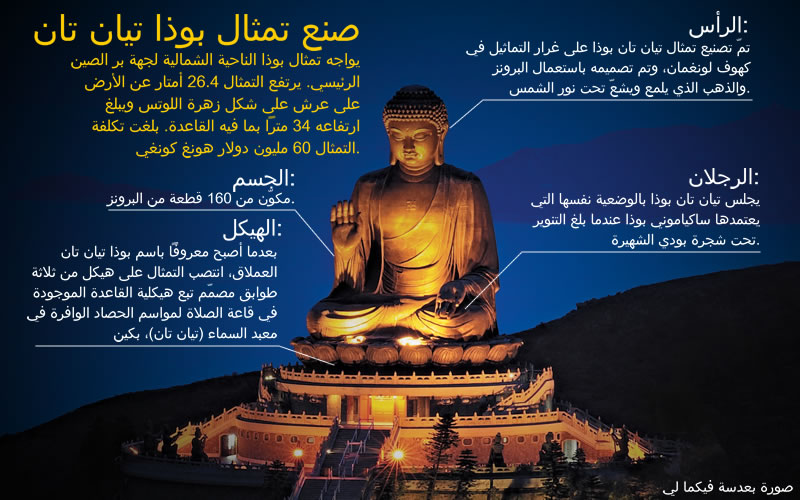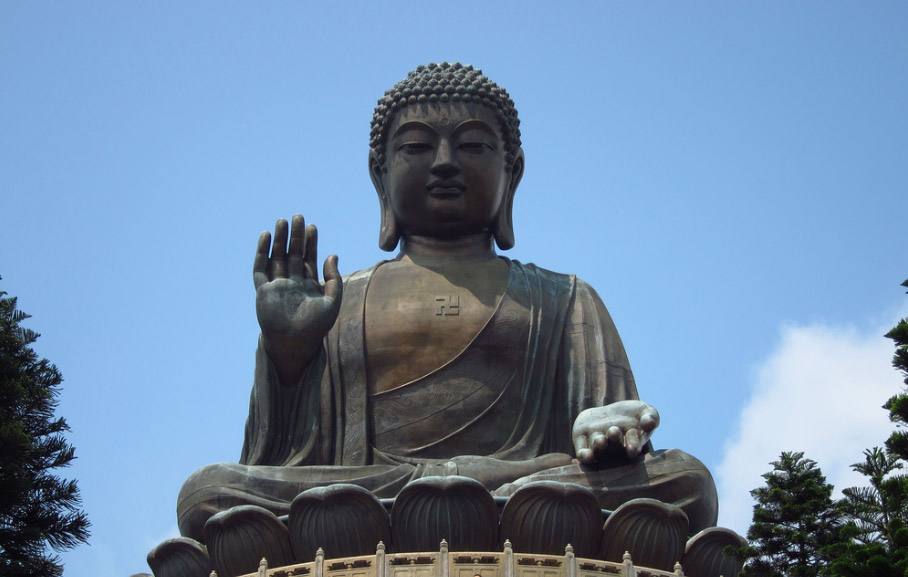تمثال تيان تان بوذا 天壇大佛 المعروف ببوذا الكبير إفتتح عام 1993 يواجه تمثال بوذا الناحية الشمالية لجهة بر الصين الرئيسي، يرتفع التمثال 26.4 أمتار عن الأرض على عرش على شكل زهرة اللوتس ويبلغ ارتفاعه 34 متراً بما فيه القاعدة، بلغت تكلفة التمثال 60 مليون دولار هونج كونج، يجتذب التمثال حجاجاً من جميع أنحاء آسيا، للوصول إلي التمثال يجب صعود 268 درجة.
– أوقات العمل:
يومياً من الساعة 10:00 صباحاً حتى 05:30 مساءاً
– معلومات الاتصال:
العنوان: Ngong Ping, Lantau Island, Outlying Islands, Hong Kong
الهاتف: +85229855248
الموقع الإلكتروني: www.plm.org.hk
– طريقة الوصول:
أقرب محطة أتوبيس Ngong Ping Bus Terminus
أقرب محطة مترو Tung Chung Station Exit B ثم تلفريك نغونغ بينغ
| إحداثيات |
|---|
Tian Tan Buddha
| 天壇大佛 | |
 |
|
| Coordinates | 22.254106°N 113.905144°ECoordinates: 22.254106°N 113.905144°E |
|---|---|
| Location | |
| Material | Bronze |
| Height | 34 metres (112 ft) |
| Completion date | December 29, 1993 |
Tian Tan Buddha, also known as the Big Buddha, is a large bronze statue of Buddha Shakyamuni, completed in 1993, and located at Ngong Ping, Lantau Island, in Hong Kong. The statue is sited near Po Lin Monastery and symbolises the harmonious relationship between man and nature, people and faith. It is a major centre of Buddhism in Hong Kong, and is also a popular tourist attraction.[1]
Contents
Description
The statue is named Tian Tan Buddha because its base is a model of the Altar of Heaven or Earthly Mount of Tian Tan, the Temple of Heaven in Beijing. One of the five large Buddha statues in China, it is enthroned on a lotus on top of a three-platform altar.[2] Surrounding it are six smaller bronze statues known as “The Offering of the Six Devas” that are posed offering flowers, incense, lamp, ointment, fruit, and music to the Buddha. These symbolise the Six Perfections of generosity, morality, patience, zeal, meditation, and wisdom, all of which are necessary for enlightenment.[citation needed]
The statue is 34 metres (112 ft) tall, weighs over 250 metric tons (280 short tons), and was constructed from 202 bronze pieces. In addition to the exterior components, there is a strong steel framework inside to support the heavy load. Reputedly the figure can be seen across the bay from as far away as Macau on a clear day. Visitors have to climb 268 steps to reach the Buddha,[2] though the site also features a small winding road for vehicles to accommodate the handicapped. The Buddha’s right hand is raised, representing the removal of affliction, while the left rests open on his lap in a gesture of generosity. He faces north, which is unique among the great Buddha statues, as all others face south.[citation needed]
There are also three floors beneath the statue: the halls of the Universe, of Benevolent Merit and of Remembrance. One of the most renowned features inside is a relic of Gautama Buddha,[3] consisting of some of his alleged cremated remains. Only visitors who purchase an offering for the Buddha are allowed to see the relic, entering to leave it there. There is a huge carved bell inscribed with images of Buddhas in the show room. It was designed to ring every seven minutes, 108 times a day, symbolising the release of 108 kinds of human vexations.[citation needed]
History
The Tian Tan Buddha was constructed beginning in 1990, and was finished on 29 December 1993, which the Chinese reckon as the day of the Buddha’s enlightenment. When the statue was completed, monks from around the world were invited to the opening ceremony. Distinguished visitors from mainland China, Hong Kong, Taiwan, India, Japan, Korea, Thailand, Malaysia, Singapore, Sri Lanka, and the United States all took part in the proceedings.[4]
On 18 October 1999, the Hong Kong Post Office issued a definitive issue of landmark stamps, of which the HK$2.50 value depicts the Tian Tan Buddha.[5] On 22 May 2012 it was also featured on the HK$3 value of the Five Festival set, this one celebrating the birth of Sakyamuni Buddha. The MTR corporation has also issued a souvenir ticket featuring a photograph of the statue.[citation needed]
Visiting and access
Po Lin Monastery and the Buddha are open to the public between 10:00 and 17:30. Access to the outside of the Buddha is free of charge, but there is an admission fee to go inside the Buddha.
Visitors can reach the site by bus or taxi, travelling first to Mui Wo (also known as “Silvermine Bay”) via ferry from the Outlying Islands piers in Central (pier No. 6) or to Tung Chung station via the MTR, or cable car. Visitors may then travel to and from the Buddha via the following bus routes:
- Mui Wo ↔ Ngong Ping — NLB No. 2
- Tung Chung ↔ Ngong Ping – NLB No. 23
The Ngong Ping 360 gondola lift between Tung Chung and Ngong Ping (25 minutes).[6]
Nearby attractions
- Po Lin Monastery, 0.31 km away: Buddhist monastery located next door
- Ngong Ping 360, 0.40 km away: an aerial tramway connecting Ngong Ping with private housing estate area of Tung Chung
-
One of the many sacred cows that openly roam the grounds of the Po Lin Monastery
Lantau South Country Park, 3.37 km away: a 56.4 square kilometres (21.8 sq mi) Country park/natural area
- Lantau Trail, 3.85 km away: Ngong Ping section of trail connecting with Sham Wat Road and mountain pass at Pak Kung Au
- Tai O, 4.36 km away: fishing village on Lantau Island with access by car (via Ngong Ping Road, Keng Shan Road, Tai O Road) or bus (New Lantao Bus Route 21)
See also
- Buddhist art
- Chinese Buddhism
- List of statues by height, many of which are Buddhist statues.
References
- DeWolf, Christopher “9 Hong Kong tourist traps – for better or worse” CNN Go. 27 October 2010. Retrieved 3 March 2012
- “Tian Tan Buddha”. Atlas Obscura. Retrieved 10 January 2014.
- John S. Strong, Relics of the Buddha (Princeton: Princeton University Press, 2004)
- The monastery website
- “Hongkong Post Stamps – Library”. hongkongpoststamps.hk.
External links
| Wikimedia Commons has media related to Tian Tan Buddha. |
- About the top 5 biggest Buddha statues in China
- Pictures of the Po Lin Monastery and the Tian Tan Buddha
- “Hong Kong’s official factsheet (Simplified Chinese)” (PDF). Archived from the original (PDF) on 27 March 2003. (300 KiB)
- Video of the climb up the steps to Tian Tan Buddha
-
هل كنت تعلم؟

بوذا الكبير ودير بو لين
كان دير بو لين في الماضي ديرًا نائيًا تحتضنه الأعشاب الخصبة ومناظر الجبال، إلاّ أنّه برز على خريطة العالم عندما انتصب تمثال تيان تان بوذا (المعروف بشكل غير رسمي ببوذا الكبير) عام 1993. يجتذب تمثال بوذا البرونزي المهيب الذي يرتفع 34 متراً عن الأرض حجاجاً من جميع أنحاء آسيا، ويقف مواجهاً للشمال ليطلّ على الشعب الصيني.
تجتمع العينان والشفتان وانحناءة الرأس واليد اليمنى التي ارتفعت لتبارك الجميع لتضفي فطنةً وكرامةً إلى تمثال بوذا الكبير الذي استغرق انجازه 12 سنة. اصعد الدرجات المئتين والثمانية والستين لتشاهد عن كثب هذا التمثال اللافت وتستمتع بمناظر الجبل والبحر الفاتنة التي يمكن رؤيتها من قاعدته.
في الجهة المقابلة للتمثال، يشكّل دير بو لين واحداً من أهم الأماكن المقدّسة في هونغ كونغ وقد أطلق عليه اسم ’العالم البوذي في الجنوب‘. يزخر هذا الدير، الذي يعتبر مأوى للعديد من الرهبان المتديّنين، بأيقونات بوذية زاهية الألوان وتتراقص حديقته الجميلة على تغريد العصافير وعطور الأزهار. يمكنك أن تطلق العنان لشهيتك في مطعم الدير النباتي الشعبي.















Leave a Reply
You must be logged in to post a comment.